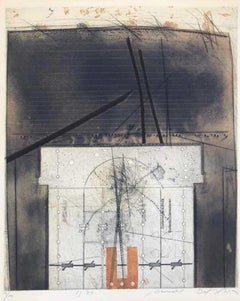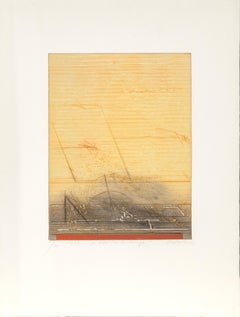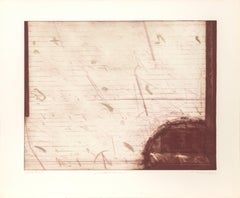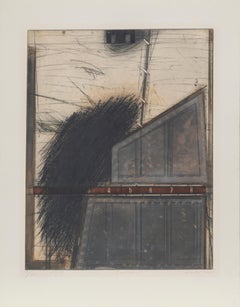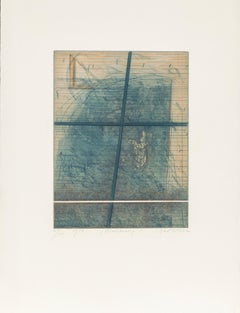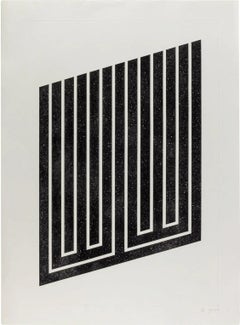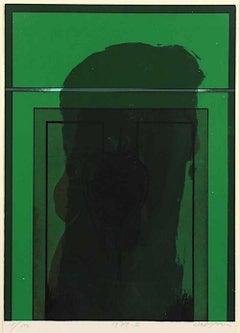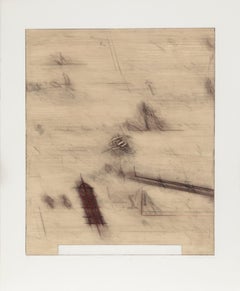Karl Fred Dahmen Art
German, 1917-1981
Karl Fred Dahmen (1917–1981) was a German painter, sculptor, and printmaker known for his dynamic abstract compositions and expressive use of color and form. Born in Stolberg, Germany, Dahmen initially trained as a blacksmith before studying painting at the Kunstakademie Düsseldorf. He emerged as a prominent figure in the post-war German art scene, experimenting with various styles including abstraction and gestural painting. Dahmen's work often explored themes of nature, industrialization, and the human condition, reflecting his own experiences and observations of the world around him. Throughout his career, he exhibited extensively in Germany and internationally, gaining recognition for his innovative approach to art-making. Today, Dahmen's works can be found in major museums and collections worldwide, where they continue to captivate audiences with their vibrant energy and emotive power.to
1
1
1
4
4
2
Overall Width
to
Overall Height
to
12
7
4
6
6
8
4
7
6
4
4
4
12
7,763
4,946
2,504
1,372
1
9
11
1
Artist: Karl Fred Dahmen
Germat - Etching by Karl Fred Dahmen
By Karl Fred Dahmen
Located in Roma, IT
Germat is an original color etching realized by the German artist Karl Fred Dahmen in 1974.
Hand-signed, titled, dated and numbered on the lower margin. Edition 94 of 100 prints.
...
Category
1970s Abstract Expressionist Karl Fred Dahmen Art
Materials
Etching
Fin Ph. O., Aquatint Etching by Karl Fred Dahmen
By Karl Fred Dahmen
Located in Long Island City, NY
Artist: Karl Fred Dahmen (German, 1917-1981)
Title: Fin Ph. O.
Year: circa 1979
Medium: Aquatint Etching, signed, numbered, dated, and titled in pencil
Edition: 75
Image Size: 16 x...
Category
1970s Minimalist Karl Fred Dahmen Art
Materials
Etching, Aquatint
Growth/ A Warm Letter, Abstract Aquatint Etching by Karl Fred Dahmen
By Karl Fred Dahmen
Located in Long Island City, NY
Artist: Karl Fred Dahmen
Title: Growth / A Warm Letter
Year: 1980
Medium: Aquatint Etching, signed, numbered, dated, and titled in pencil
Edition: 75
Image Size: 22 x 28.25 inches
S...
Category
1970s Minimalist Karl Fred Dahmen Art
Materials
Etching, Aquatint
Bastion, Abstract Aquatint Etching by Karl Fred Dahmen
By Karl Fred Dahmen
Located in Long Island City, NY
Artist: Karl Fred Dahmen
Title: Bastion
Year: 1976
Medium: Aquatint Etching, Signed, numbered, dated, and titled in pencil
Edition: 49/75
Size: 35 in. x 27.5 in. (88.9 cm x 69.85 cm)
Category
1970s Minimalist Karl Fred Dahmen Art
Materials
Etching, Aquatint
Laffly, Abstract Aquatint Etching by Karl Fred Dahmen
By Karl Fred Dahmen
Located in Long Island City, NY
Artist: Karl Fred Dahmen
Title: Laffly
Year: 1979
Medium: Etching and Aquatint, signed and numbered in pencil
Edition: 14/75
Size: 27 in. x 22.5 in. (68.58 cm x 57.15 cm)
Frame...
Category
1970s Minimalist Karl Fred Dahmen Art
Materials
Aquatint, Etching
Blankrenz, Abstract Aquatint Etching by Karl Fred Dahmen
By Karl Fred Dahmen
Located in Long Island City, NY
Artist: Karl Fred Dahmen (German, 1917-1981)
Title: Blankrenz
Year: circa 1979
Medium: Aquatint Etching, signed, numbered, dated, and titled in pencil
Edition: 75
Image Size: 16 x ...
Category
1970s Minimalist Karl Fred Dahmen Art
Materials
Etching, Aquatint
Tagebuch August, Abstract Minimalist Mixed Media Drawing by Dahmen
By Karl Fred Dahmen
Located in Long Island City, NY
Artist: Karl Fred Dahmen
Title: Tagebuch August
Year: 1980
Medium: Drawing with Mixed Media on Paper, signed
Size: 31 x 24.5 in. (78.74 x 62.23 cm)
Category
1980s Abstract Expressionist Karl Fred Dahmen Art
Materials
Mixed Media, Laid Paper
Abstract Minimalist Mixed Media Drawing by Karl Dahmen
By Karl Fred Dahmen
Located in Long Island City, NY
Artist: Karl Fred Dahmen
Title: Untitled 1
Year: 1980
Medium: Drawing with Mixed Media on Paper, signed and dated
Size: 17 x 22 in. (43.18 x 55.88 cm)
Category
1980s Abstract Expressionist Karl Fred Dahmen Art
Materials
Mixed Media, Laid Paper
Abstract Mixed Media Drawing on paper by Karl Fred Dahmen
By Karl Fred Dahmen
Located in Long Island City, NY
Artist: Karl Fred Dahmen
Title: Untitled 2
Year: 1980
Medium: Drawing with Mixed Media on Paper, signed verso
Size: 33 x 41.5 in. (83.82 x 105.41 cm)
Category
1980s Abstract Expressionist Karl Fred Dahmen Art
Materials
Mixed Media, Laid Paper
Untitled 3, Mixed Media Drawing on paper by Karl Fred Dahmen
By Karl Fred Dahmen
Located in Long Island City, NY
Artist: Karl Fred Dahmen
Title: Untitled 3
Year: 1980
Medium: Drawing with Mixed Media on Paper, signed verso
Size: 33.5 x 45 in. (85.09 x 114.3 cm)
Category
1980s Abstract Expressionist Karl Fred Dahmen Art
Materials
Mixed Media, Laid Paper
Semiotische Komposition, Abstract Geometric Aquatint Etching by Karl Fred Dahmen
By Karl Fred Dahmen
Located in Long Island City, NY
Artist: Karl Fred Dahmen
Title: Semiotische Komposition
Year: 1977
Medium: Aquatint Etching, signed, numbered, dated, and titled in pencil
Edition: 49/75
Image Size: 27.5 x 21.5 inc...
Category
1970s Minimalist Karl Fred Dahmen Art
Materials
Etching, Aquatint
February (abstract print from Domberger series)
By Karl Fred Dahmen
Located in New York, NY
From the "Edition Domberger 1980"
Signed and numbered with publisher embossing
Category
20th Century Abstract Expressionist Karl Fred Dahmen Art
Materials
Screen
Related Items
Donald Judd 'Untitled, 1978-79' Signed, Limited Edition Aquatint Print
By Donald Judd
Located in San Rafael, CA
Donald Judd (American 1928-1994)
Untitled, 1978-79.
Aquatint on etching paper
Signed and numbered 18/175 in pencil (there were also 15 artist's proofs)
Published by the artist, with ...
Category
1970s Minimalist Karl Fred Dahmen Art
Materials
Aquatint
H 40 in W 29.5 in D 0.02 in
Untitled 148
By Gino Scarpa
Located in Austin, TX
Artist: Gino Scarpa, Italian/Norwegian (1924 - )
Title: Untitled 148
Year: circa 1970
Medium: Aquatint Etching and Carborundum Intaglio print
Signed and numbered in pencil, Numbe...
Category
1970s Abstract Expressionist Karl Fred Dahmen Art
Materials
Etching, Aquatint, Intaglio
Violet composition - Etching by Oscar Piattella - 1975
By Oscar Piattella
Located in Roma, IT
Violet composition is an original artwork realized in 1975 by Oscar Piattella.
Hand signed, dated on the lower right margin.
Numbered on the lower left. Edition of 54/100 prints.
...
Category
1970s Minimalist Karl Fred Dahmen Art
Materials
Etching
H 27.56 in W 20.48 in D 0.04 in
Dark Landscape (abstract expressionist)
By Gabor F. Peterdi
Located in Wilton Manors, FL
Gabor Peterdi (1915-2001). Dark Landscape, 1958. Etching, engraving and aquatint with five stenciled colors. Image measures 20 x 24 inches. Signed, date...
Category
Mid-20th Century Abstract Expressionist Karl Fred Dahmen Art
Materials
Engraving, Etching, Aquatint
Abstract Color Field Gradient Monoprint Aquatint Etching California Minimalism
By Joe Novak
Located in Surfside, FL
"Voices XXI"
Aquatint Etching • Monoprint
Image: 12”x 14” • Paper: 30”x 22” • 2001
Hand signed and numbered 1/1 on BFK Rives paper.
Joe Novak (1930-2019) California Contemporary Minimalist. His work is about the exploration of color and light through abstraction, with tonal gradations that infuse them with a meditative quality. During the eighties and nineties, he painted large monochromatic color field canvases with tonal gradations and soft edges that infuse them with a meditative quality and a sense of movement. When illuminated they become glowing surfaces of color and light. His artistic background and work link him closely with the first generation abstract expressionists of the New York School. Major influences include Jackson Pollock and Mark Rothko, and his mentors, Peter Busa and Esteban Vicente, whom he met and befriended during the eighties while living and painting in East Hampton. During the nineties, while living and working in Santa Fe, New Mexico, Novak initiated a project called "Light Emanations", in which he created digital computerized programs of changing light levels and configurations on a selection of his large paintings, dramatically illustrating the effect of light changes on color perception. Novak's body of work is extensive and include painting on canvas, panel and paper as well as monotypes, drawings, assemblages, mixed media and prints. He has often worked in series, focusing on a particular medium for years. Among these are "Meditations" (color pencil drawings), "Voices" and "Voices 2" (color aquatint etchings), "Echoes" (painting assemblage with minerals) and "Colors" (350 miniature panel paintings). In recent years his paintings have become more gestural, often with musical allusions. His work bears a relationship to the Light & Space Movement and Minimalism artists James Turrell, Larry Bell, Craig Kauffman, Billy Al Bengston, Peter Alexander, Laddie John Dill, Lita Albuquerque. these are also anticipative of the aquatint etching works by Anish Kapoor. Color Gradient, Abstract Art, Land Art. During the eighties and nineties, he painted large monochromatic color field canvases with tonal gradations and soft edges that infuse them with a meditative quality and a sense of movement. When illuminated they become
glowing surfaces of color and light. Critic Christopher Knight wrote, Novak is an unabashed Color Field painter. His paintings and aquatints at Bert Green Fine Arts — the Santa Fe artist's third show there — feature works that will call to mind abstractions as diverse as those by Helen Frankenthaler, Mark Rothko and Morris Louis and the landscape abstractions of Joe Goode. Novak's work is in many public and private collections, including numerous museum collections. He spent his last years living in Palm Springs.
Selected Group Exhibitions
Bert Green Fine Art, Chicago, Illinois
"Joe Novak/Huck Lewis-Bennett: A Collaboration", Stephen Archdeacon Gallery, Palm Springs
Melissa Morgan Fine Art...
Category
Early 2000s Minimalist Karl Fred Dahmen Art
Materials
Color, Etching, Aquatint, Monoprint
Large Aquatint Etching A Red Color MInimalist Abstract Etching Robert Mangold
By Robert Mangold
Located in Surfside, FL
A Red, from Three Aquatints, 1979
Aquatint on six copper plates printed on Rives BFK paper
Paper Size: 40 3/4 x 40 3/4 inches (103.5 x 103.5 cm); Image Size: 33 x 33 inches (83.8 x 83.8 cm)
Signed and titled lower left front Edition of 50, 10 AP, 3 TP
Published by Parasol Press, New York Printed by Hidekatsu Takada, assisted by David Kelso, Crown Point Press, Oakland, California
Robert Mangold (born October 12, 1937) is an American minimalist artist. He is also father of film director and screenwriter James Mangold. Mangold first trained at the Cleveland Institute of Art from 1956-59, and then at Yale University, New Haven, (BFA, 1961; MFA, 1963).
In 1961 he married Sylvia Plimack, and they moved to New York. In the summer of 1962 Mangold was hired as guard at the Museum of Modern Art.
Mangold's work challenges the typical connotations of what a painting is or could be, and his works often appear as objects rather than images. Elements refer often to architectural elements or have the feeling architecture to them. He almost always works in extensive series, often carried through both paintings and lithograph works on paper. Mangold’s early work consisted largely of monochromatic free-standing constructions. In 1968 he began employing acrylic instead of oil painting, rolling rather than spraying it on Masonite or plywood grounds. Within the year, he moved from these more industrially oriented supports to canvas. In 1970 he began working with shaped canvases and within the year began brushing rather than spraying paint onto canvas. Mangold made his first prints in 1972 at Crown Point Press and has made prints throughout his career, working with Pace Editions and Brooke Alexander Editions.
In 1965, the Jewish Museum in New York held the first major exhibition of what was called Minimal art (Minimalism) and included Robert Mangold. In 1967, he won a National Endowment for the Arts grant and in 1969, a Guggenheim Fellowship. In 1971, he had his first solo museum exhibition at the Guggenheim Museum. Major museum exhibitions of his work have since been held the Museum of Contemporary Art, San Diego (1974), the Stedelijk Museum in Amsterdam (1982), Hallen für Neue Kunst in Schaffhausen (1993), and Musée d’Orsay in Paris (2006). He has been featured in the Whitney Biennial four times, in 1979, 1983, 1985, and 2004. His work is related to Geometric Abstraction.
Select Exhibitions
Robert Mangold, Bruce Nauman, Richard Serra: Extended Drawing, Bonnefantenmuseum
Accrochage: Donald Judd, Louise Lawler, Sol LeWitt, and Robert Mangold, Galerie Greta Meert,
Carl Andre, Dan Flavin, Donald Judd, Robert Mangold, Robert Ryman, Andrea Rosen Gallery, NY
Tara Donovan, Sol LeWitt, Robert Mangold, James Siena: Minimalist Prints, Augen Gallery, Portland
Modulated Abstraction: Josef Albers, Carl Andre, Donald Judd, Ellsworth Kelly, Sol LeWitt, Robert Mangold, Fred Sandback, Richard Tuttle, Brooke Alexander Editions, New York, NY
Drawings from the 1970’s, Mel Bochner, Robert Mangold, Robert Moskowitz, Fred Sandback, Richard Tuttle, Lawrence Markey, New York, NY
Systematic: Anne Appleby...
Category
1970s Minimalist Karl Fred Dahmen Art
Materials
Etching, Aquatint
Bernar Venet, Acute Uneven Angles (A), Gravure aquatint burnishing and Drypoint
By Bernar Venet
Located in New York, NY
Bernar Venet
Acute Uneven Angles (A), 2016
Direct gravure, aquatint, burnishing and drypoint.
Pencil signed and numbered 42 from the limited edition of 75 by the artist on the front
...
Category
2010s Minimalist Karl Fred Dahmen Art
Materials
Etching, Aquatint, Engraving
Historic invitation poster for 1970 ACE Gallery exhibition Minimalist light art
By Dan Flavin
Located in New York, NY
Dan Flavin
Rare invitation poster for 1970 ACE Gallery exhibition, 1970
Letterpress and stencil on colored paper
Not signed
Frame included
Floated in the original ACE gallery vintage wood frame.
Measurements:
Framed:
17.75" x 17.75" x 1.6 inches
Poster:
16 inches x 16 inches
Extremely uncommon letterpress and stencil poster designed by Dan Flavin on the occasion of his 1970 exhibition “Two Cornered Installations in Colored Fluorescent Light from Dan Flavin” at the legendary Ace Gallery in Los Angeles. The poster, like most exhibition invitations of that era (including those from the Leo Castelli gallery in New York) was undated, as these works were so much of the moment. This work was acquired directly from the collection of the ACE Gallery.
Other than the present work, we've never seen another example of this collectors item anywhere in the world, on or off the market (If anyone is aware of others, we'd love to see!)
More about the legendary ACE gallery, and the sale of some of its art collection from the bankruptcy estate, from where the present work was acquired:
ACE Gallery founder Douglas Chrismas opened his own frame shop and gallery in Vancouver at the age of 17. His gallery became known as a venue where Vancouver artists could show alongside major New Yorkers, and get the feeling of belonging to a bigger scene. In the 60s and early 70s he brought artists such as Robert Rauschenberg, Carl Andre, Sol LeWitt, Bruce Nauman, and Donald Judd to Vancouver, Canada.
The gallery expanded to Los Angeles in 1967 at the former Virginia Dwan Gallery space in Westwood, and then further expanded to New York in 1994. The galleries were noted for doing museum-level exhibitions by up and coming and internationally renowned artists. While in New York the gallery’s presence was amplified by doing exhibitions in conjunction with cultural institutions such as the Guggenheim Museum and the Cartier Foundation (Paris). Under Chrismas' directorship, ACE Gallery has had either offices or galleries in art centers outside of the United States, such as Mexico City, Paris, Berlin. and Beijing.
In 1972, Chrismas mounted Robert Irwin’s installation Room Angle Light Volume at the first ACE/Venice, which opened at 72 Market Street in 1971. In 1977, ACE mounted exhibitions of work by Frank Stella and Robert Motherwell, along with Michael Heizer’s Displaced/Replaced Mass. Installed at ACE/Venice, the Heizer piece required that huge chunks be gouged out of the gallery floor to create recessed areas able to accommodate boulders.
In April 2016, ACE Gallery emerged from a three-year bankruptcy proceeding under the leadership of Sam S. Leslie. In May 2016, founder Douglas Chrismas was terminated from all roles at the gallery.
In July 2021, Douglas Chrismas was arrested by the FBI and charged with embezzlement.
In May 2022, Douglas Chrismas was ordered to repay 14.2 million in ACE art sale profits, which were diverted to personal accounts.
Chrismas is awaiting criminal trial in January, 2023. He faces up to 15 years in prison if convicted.
Controversies
In a 1983 lawsuit in Los Angeles federal court, Rauschenberg sought $500,000 from Chrismas' Flow ACE Gallery; the artist won a $140,000 judgment in the suit in 1984. Eventually the two reconciled their differences and in 1997 Robert Rauschenberg insisted that ACE Gallery New York (in conjunction with the Guggenheim Museum) host his Retrospective.
In 1986, Chrismas pleaded no contest after Canadian real estate developer C. Frederick Stimpson alleged that he had improperly sold work belonging to the collector, among them pieces by Andy Warhol and Rauschenberg. Under the terms of the settlement, Chrismas agreed to pay Stimpson $650,000 over a period of five years. He continues to work with the Stimpson family in handling their art interests.
In 1989, ACE Gallery wanted to borrow a work by Judd along with Carl Andre's 1968 Fall, both owned by Count Giuseppe Panza, for an exhibition devoted to minimal art called The Innovators Entering into the Sculpture. Rather than shipping the two large scale works from Italy, Panza authorized ACE Gallery to refabricate the pieces in Los Angeles. In Panza's collection archives, there is a series of signed certificates signed by Judd that granted Panza broad authority over the works by Judd in his collection. These certificates "authorized Panza and followers to reconstruct work for a variety of reasons," as long as instructions and documentation provided by Judd were followed and either he or his estate was notified. This even included the right to make "temporary exhibition copies, as long as the temporary copy was destroyed after the exhibition; and the right to recreate the work to save expense and difficulty in transportation as long as the original was then destroyed." Miwon Kwon, in her account of site specificity: "One Place After Another," presents the account of ACE Gallery recreating artworks by Donald Judd and Carl Andre without the artist's permission. Andre and Judd both publicly denounced these recreations as "a gross falsification" and a "forgery," in letters to Art in America, however, the fabrication of the pieces were permitted by Panza Collection in Italy, the owner of the works. Despite the confusion surrounding the Panza refabrications, both Carl Andre and Donald Judd maintained a professional relationship with Douglas Chrismas and ACE Gallery. Andre showcased works at ACE Gallery in 1997, 2002, 2007, 2011 and present day. In 2007, Carl Andre's show entitled "Zinc" was exhibited at ACE Gallery in Beverly Hills. Donald Judd paid a visit to The Innovators Entering into the Sculpture exhibition at ACE Gallery and agreed to keep his sculpture in the exhibition. After the exhibition was over, Chrismas planned to sell the metal used for the re-fabrication of Judd's work for scrap metal but Judd wanted to own the re-fabrication for himself. ACE Gallery then sold the re-fabrication of Donald Judd's work to Donald Judd.
After having consigned more than $4 million worth of art to ACE Gallery to sell in 1997 and 1998, the sculptor Jannis Kounellis filed a lawsuit in Los Angeles Superior Court in 2006, accusing Chrismas of keeping most of the profits of artworks and refusing to return the pieces that did not sell. According to the lawsuit, the primary agreement between Kounellis and Chrismas was oral. Chrismas returned all of Kouenllis' artwork, and did a full accounting of the proceeds from Kounellis' work—minus the expense of exhibiting it. The matter was resolved between the two of them and ACE Gallery still sells and exhibits Kounellis' work today.
By 2006, Chrismas had filed for Chapter 11 bankruptcy protection at least six times since 1982, barring most of his creditors from collecting the money immediately owed to them. Chrismas filed for Chapter 11 bankruptcy to protect the gallery's extensive real estate holdings from the problematic landlord. The landlord of the Wilshire Boulevard space, Wilshire Dunsmuir Company, claimed that ACE owed back rent and penalties however, the claim was disputed by Douglas Chrismas. In court papers, Chrismas Fine Art claimed that it would cure "the pre-petition" debt by Feb. 1, 2000, and was asking the court to protect its right to remain in the property. A declaration filed by Douglas Chrismas characterized this leasehold as the business' primary asset.
-Courtesy Wikipedia
About Dan Flavin
Dan Flavin (1933–1996) was a pioneer of Minimal Art. He rose to fame in the 1960s with his work with industrially manufactured fluorescent tubes, inventing a new art form and securing his place in art history. The exhibition at the Kunstmuseum Basel focuses on his works that are dedicated to other artists or make reference to certain events.
Back in 1963 Dan Flavin mounted a single, industrial fluorescent light tube at a 45-degree angle to the wall of his studio declaring it art; the act was radical, and it still is. Indeed, it was owing to this action that standard commercial products would be introduced into art: The nascent Minimal Art of the era emphasised seriality, reduction and matter-of-factness. Somewhat ironically, while the autodidact Flavin never himself sought membership to this movement in art, he would, and quite literally, go on to become one of its most illustrious exponents.
Flavin began work with fluorescent light tubes from the early 1960s on; arranged in so-called ‘situations’, he would then further develop them into series and large-scale installations. The colours and dimensions of the materials he used were prescribed by industrial production. Flooded in light, viewers themselves become part of the works: The space, along with the objects within it, are set in relation to each other and thus become immersive experiences of art triggering sensual, almost spiritual experiences.
Flavin liberated color from the two-dimensionality of painting. The prevalent perception of his light works has, to date, largely centred on their minimalist, industrial aspect, and thus on the inherent simplicity of their beauty. The exhibition at Kunstmuseum Basel, by contrast, places emphasis on looking at Flavin’s oeuvre in a less familiar setting: His pieces, although initially without clearly recognisable signature, frequently make reference in their titles to concrete events, such as wartime atrocities or police violence, or are dedicated to other artists—as in the work untitled (in memory of Urs Graf...
Category
1970s Minimalist Karl Fred Dahmen Art
Materials
Etching, Stencil
H 17.75 in W 17.75 in D 1.6 in
Two Open Squares Within a Green Area
By Robert Mangold
Located in New York, NY
Associated with the Minimalist art movement of the 1960s, Mangold developed a reductive vocabulary based on geometric forms, monochromatic color, and an emphasis on the flatness of t...
Category
2010s Minimalist Karl Fred Dahmen Art
Materials
Etching
Two Open Squares Within a Red Area
By Robert Mangold
Located in New York, NY
Associated with the Minimalist art movement of the 1960s, Mangold developed a reductive vocabulary based on geometric forms, monochromatic color, and an emphasis on the flatness of t...
Category
2010s Minimalist Karl Fred Dahmen Art
Materials
Paper, Etching, Aquatint
'Feu sous L'eau' (Fire Under Water) —Mid-century Modernism, Atelier 17
By Stanley William Hayter
Located in Myrtle Beach, SC
Stanley William Hayter, 'Feu sous L'eau (Fire Under Water)', color engraving, soft-ground etching and scorper with yellow silkscreen, 1955, edition 50 plus 10 artist proofs, Black & Moorhead 221. Signed, titled 'Fire Under Water', dated and annotated 'Essai' in pencil. Dedicated in the artist’s hand 'for Adja & Dove WH Bill 17–5–55' in the top margin. A superb, richly inked impression with fresh colors, on heavy, cream wove paper; wide margins (2 1/2 to 3 7/8 inches), in excellent condition. One of 10 artist’s proofs. Image size 10 3/16 x 7 inches; sheet size 18 1/8 x 12 1/4 inches. Matted to museum standards, unframed.
ABOUT THIS WORK
In 1950 Hayter returned to Paris and reopened Atelier 17. Works such as 'Fire Under Water' reveal newfound influences, such as that of the Ardèche area of southern France, where he acquired a house in 1951 and frequently visited. Hayter took great interest in the flowing Escoutay River, an experience that parallels the artist and co-director of Atelier 17 Krishna Reddy’s interest in depicting water. While some forms in this print evoke the natural world, the palette of contrasting tones of purple, yellow, black, and white reflects Hayter’s belief in using color intuitively to express emotions and evoke feelings. The sharp white relief lines from the paper and the textural effects realized through soft-ground etching operate in tandem with the sweeping curves and bold colors to give the composition a sense of vitality and dynamism.
—edited from the Metropolitan Museum of Art
Published by 'La Jeune Gravure Contemporaine', Paris.
Impressions of this work are in the following collections: British Museum, Metropolitan Museum of Art, National Gallery of Art.
ABOUT THE ARTIST
Stanley William Hayter (1901-1988) was a British painter and printmaker associated in the 1930s with Surrealism and from 1940 onward with Abstract Expressionism. Regarded as one of the most significant printmakers of the 20th century, Hayter founded the legendary Atelier 17 studio in Paris, now known as Atelier Contrepoint. Among the artists he is credited with influencing are Pablo Picasso, Alberto Giacometti, Joan Miró, Alexander Calder, and Marc Chagall.
The hallmark of the workshop was its egalitarian structure, breaking sharply with the traditional French engraving studios by insisting on a cooperative approach to labor and technical discoveries. In 1929 Hayter was introduced to Surrealism by Yves Tanguy and André Masson, who, with other Surrealists, worked with Hayter at Atelier 17. The often violent imagery of Hayter’s Surrealist period was stimulated in part by his passionate response to the Spanish Civil War and the rise of Fascism. He organized portfolios of graphic works to raise funds for the Spanish cause, including Solidarité (Paris, 1938), a portfolio of seven prints, one of them by Picasso. Hayter frequently exhibited with the Surrealists during the 1930s but left the movement when Paul Eluard was expelled. Eluard’s poem Facile Proie (1939) was written in response to a set of Hayter’s engravings. Other writers with whom Hayter collaborated included Samuel Beckett and Georges Hugnet.
Hayter joined the exile of the Parisian avant-garde in 1939, moving with his second wife, the American sculptor Helen Phillips...
Category
1950s Abstract Expressionist Karl Fred Dahmen Art
Materials
Engraving, Etching
Abstract Color Field Red Purple Gradient Aquatint Etching California Minimalism
By Joe Novak
Located in Surfside, FL
"Voices IX"
Aquatint Etching •
Image: 12”x 14” • Paper: 30”x 22” • 2001
Hand signed and numbered 2/2 on BFK Rives paper.
Joe Novak (1930-2019) California Contemporary Minimalist. His work is about the exploration of color and light through abstraction, with tonal gradations that infuse them with a meditative quality. During the eighties and nineties, he painted large monochromatic color field canvases with tonal gradations and soft edges that infuse them with a meditative quality and a sense of movement. When illuminated they become glowing surfaces of color and light. His artistic background and work link him closely with the first generation abstract expressionists of the New York School. Major influences include Jackson Pollock and Mark Rothko, and his mentors, Peter Busa and Esteban Vicente, whom he met and befriended during the eighties while living and painting in East Hampton. During the nineties, while living and working in Santa Fe, New Mexico, Novak initiated a project called "Light Emanations", in which he created digital computerized programs of changing light levels and configurations on a selection of his large paintings, dramatically illustrating the effect of light changes on color perception. Novak's body of work is extensive and include painting on canvas, panel and paper as well as monotypes, drawings, assemblages, mixed media and prints. He has often worked in series, focusing on a particular medium for years. Among these are "Meditations" (color pencil drawings), "Voices" and "Voices 2" (color aquatint etchings), "Echoes" (painting assemblage with minerals) and "Colors" (350 miniature panel paintings). In recent years his paintings have become more gestural, often with musical allusions. His work bears a relationship to the Light & Space Movement and Minimalism artists James Turrell, Larry Bell, Craig Kauffman, Billy Al Bengston, Peter Alexander, Laddie John Dill, Lita Albuquerque. these are also anticipative of the aquatint etching works by Anish Kapoor. Color Gradient, Abstract Art, Land Art. During the eighties and nineties, he painted large monochromatic color field canvases with tonal gradations and soft edges that infuse them with a meditative quality and a sense of movement. When illuminated they become
glowing surfaces of color and light. Critic Christopher Knight wrote, Novak is an unabashed Color Field painter. His paintings and aquatints at Bert Green Fine Arts — the Santa Fe artist's third show there — feature works that will call to mind abstractions as diverse as those by Helen Frankenthaler, Mark Rothko and Morris Louis and the landscape abstractions of Joe Goode. Novak's work is in many public and private collections, including numerous museum collections. He spent his last years living in Palm Springs.
Selected Group Exhibitions
Bert Green Fine Art, Chicago, Illinois
"Joe Novak/Huck Lewis-Bennett: A Collaboration", Stephen Archdeacon Gallery, Palm Springs
Melissa Morgan Fine Art...
Category
Early 2000s Minimalist Karl Fred Dahmen Art
Materials
Color, Etching, Aquatint, Monoprint
Previously Available Items
Untitled - Original Screen Print by Karl Fred Dahmen - 1971
By Karl Fred Dahmen
Located in Roma, IT
Untitled is an original color serigraph realized by the German artist Karl Fred Dahmen (1917-1981) in 1971.
Signed, dated and numbered on the lower margin. Edition 68 of 100 prints....
Category
1970s Abstract Expressionist Karl Fred Dahmen Art
Materials
Screen
H 21.66 in W 17.33 in D 0.08 in
Simmerischer Gercheheim, Abstract Aquatint Etching by Karl Fred Dahmen
By Karl Fred Dahmen
Located in Long Island City, NY
Artist: Karl Fred Dahmen
Title: Simmerischer Gercheheim
Year: 1979
Medium: Aquatint Etching, signed, numbered, dated, and titled in pencil
Edition: 57/75
Size: 35 x 28.5 inches (88.9...
Category
1970s Minimalist Karl Fred Dahmen Art
Materials
Etching, Aquatint
H 35 in W 27.5 in D 0.1 in
Karl Fred Dahmen art for sale on 1stDibs.
Find a wide variety of authentic Karl Fred Dahmen art available for sale on 1stDibs. You can also browse by medium to find art by Karl Fred Dahmen in etching, aquatint, laid paper and more. Much of the original work by this artist or collective was created during the 20th century and is mostly associated with the minimalist style. Not every interior allows for large Karl Fred Dahmen art, so small editions measuring 17 inches across are available. Customers who are interested in this artist might also find the work of Carmen Cicero, Hans Hofmann, and Sandra Phipps MacDiarmid. Karl Fred Dahmen art prices can differ depending upon medium, time period and other attributes. On 1stDibs, the price for these items starts at $600 and tops out at $3,850, while the average work can sell for $1,375.
